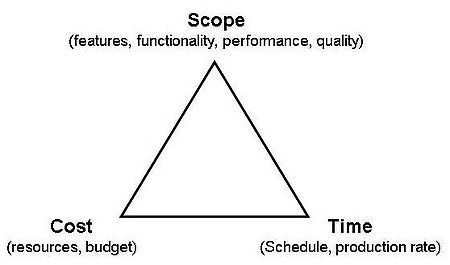Project Management Triangle
The Project Management Triangle (called also Triple Constraint or the Iron Triangle) is a model of the constraints of project management.The triangle is used by managers to analyze or understand the difficulties that may arise due to implementing and executing a project.It is used to illustrate that project management success is measured by the project team's ability to manage the project, so that the expected results are produced while managing time and cost.All projects irrespective of their size will have many constraints.Although there are many such project constraints, these should not be barriers for successful project execution and for the effective decision making.There are three main interdependent constraints for every project; time, cost and scope.[1] They are a part of every project and though they can be limiting, when properly managed they should not affect a successful project outcome. These are often characterized in the Project Management Triangle.
If we broaden this view and talk about projects, the triangle is a necessity for any project regardless of its size and nature. All three factors in the triangle have a single bounding force, i.e. “project success”. These constraints are highly interrelated to each other and any change in any one of the factor will affect the other two factors negatively or positively.The purpose of any Project Manager is to maintain a balance between the three factors to make the project successful. In most of the projects the shape of the triangle will not be equilateral because of the change in cost, scope and might be time over the cycle of the project. For example change in cost of work will surely affect the scope and time or change in scope will affect the other two factors. In well-defined projects (where scope definition is clear and detailed) there are fewer chances that the triangle will change its shape by great differences and in any poorly defined project it is vice versa, therefore it is always a good idea for Project Managers to put considerable amount of effort & time to outline the scope of the project as detailed as possible so there will be fewer chances in the variation of cost and time.Quality is another dimension which is related to PMT and many people believe that the outcome of triple constraint is quality. Majorly quality can be improved by increasing the cost and resources but as a project management professional we should keep the quality bench marks as such where cost should not increase beyond the acceptable level. It’s a good practice for project managers to keep routine checks on the progress of project and to use correct and efficient resources to perform tasks. Sometime critical path reorganization and to make critical activities parallel (if possible) to each other also results in terms of efficient outcomes for time, cost and scope scheduling.[2]
The Three Constraints
The three constraints in a project management triangle are scope, time and cost. These three factors are represented as a triangle (Figure 1). Equilateral triangle shows a balance and ideal condition between time, cost and scope. The Project Manager should aim to maintain a balance between these three factors to make the project successful. In most of the projects the shape of the triangle will not be equilateral because of the change in cost, scope or time over the cycle of the project. For example, change in scope of work will surely affect the cost and time or change in cost will affect the other two factors.[3]
Time
Cite error:
<ref> tags exist, but no <references/> tag was found
